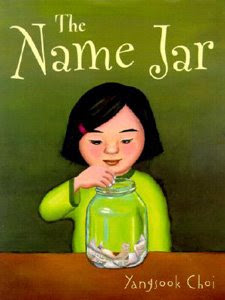Choi, Yangsook. The Name Jar. New York: Random House Children's Books, 2010. ISBN: 9780440417996.
Plot Summary:
Unhei is a Korean girl who just moved from Korea a week ago to begin school in another country where she has no friends. Like any new student, Unhei is apprehensive about her first day of school and whether or not the kids will like her. Her biggest concerns stems from the pronunciation of her name, and her biggest fears come to life when she is introduced on her first day and no one can pronounce her name -- not even the teacher. However, her classmates are incredibly in awe with the new girl who introduces herself with no name and are eager to help her choose one.
Critical Analysis:
The Name Jar is the story of a Korean girl who moves from Korea to America with her family who faces cultural boundaries concerning her name. The author and illustrator, Yangsook Choi, uses the story of the protagonist to bring attention to assimilation and social identity. The protagonist, Unhei, starts a new school, but struggles in defining herself in comparison to the American children -- more specifically, through her name and the pronunciation. On her first day of school she introduces herself as not having a name and telling her classmates she will have one within the next week. She peaks their interest and on the next day, she is welcomed by a jar that is sitting on her desk with various name choices to assist her in choice. Through this story line, the author depicts how Unhei struggles to try to fit in. For instance, after she comes home from her first day of school, Unhei tells her mother that she needs an American name so the kids in her classroom can pronounce her name. Her mother responds saying, "Why? Unhei is a beautiful name. You grandmother and I went to a name master for it." This response demonstrates the significance and importance of Korean naming practices. However, Unhei feels the need to assimilate to American culture to fit in.
For the most part, this story does a good job of accurately depicting the issues and concerns that Asians face while living in America or even growing up in America. However, the author does provide one obvious "positive stereotype" when Unhei's mother says, "You must study hard, behave nicely, and get good grades to show that you're a good Korean." This is an example of a "positive stereotype" which does the complete opposite of transcending stereotypes among Asian culture.
The author also provides illustrations for this title which aides in a positive reflection of Asian culture. For instance, there is a part in the story when Unhei and her family are at the airport saying their goodbyes to her grandmother. Choi illustrates the skin tone of the four of them with varying shades of tan. This depiction of skin tone variation accurately portrays that Asian skin tone varies from white to black. Aside from this one example of a negative depiction, the author does provide her audience with accurate portrayals of Asian culture through her context and illustrations of this title.
Review Excerpts:
"Unhee is the new girl in school. She and her family have just arrived and she feels scared and alone. Unhee can speak English very well, but she is worried her classmates will not be able to pronounce her name. Unhee decides she must choose a new American name for herself, much to her parents' dismay. Unhee's Korean grandma has given Unhee her name stamp. Her classmates think this is a wonderful possession and they envy her. Unhee discovers that the symbol on her stamp means grace. Unhee also discovers what her new name will be. Her classmates and neighbors know Unhee is looking for a new name and make many suggestions, placing their ideas in a name jar. Unhee faces her classmates and tells them she loves the names they have selected for her, but her decision has been made. Choi's beautiful art enhances her depth of the characters and adds warmness to this problem faced by so many children¾that of fitting in and being accepted." - Children's Literature
"On the way to her first day of school, Unhei is teased by the children on the bus for her Korean name. When she reaches her classroom and is asked her name, she tells her classmates that she has not yet decided on one. To be helpful the children put their suggestions into a "name jar." Eventually the girl decides to keep her own name as one of her classmates takes pride in the new Korean nickname he has chosen, Chinku, meaning "friend." The round, red imprint of the Korean character for Unhei's name provides the graphic manifestation of the story's theme. Attractive golden endpapers feature random repetitions of the stamp imprint interspersed with her classmates' handwritten suggestions on scraps of torn paper. The bold, bright paintings that illustrate the story are realistic, warm, and appealing." - School Library JournalConnections:
Customers who purchased this title also bought the following books: Recess Queen, Those Shoes, and A Chair for my Mother.
Interactivity:
- Ask children have they ever been embarrassed of their name and if they have, was it based on the response to other people.
- Facilitate a discussion on the importance of accepting everyone, especially their differences vs. trying to make someone feel ashamed of who they are.
- Allow children to go home and ask their parents why they chose their names and research the meaning of their name.

No comments:
Post a Comment